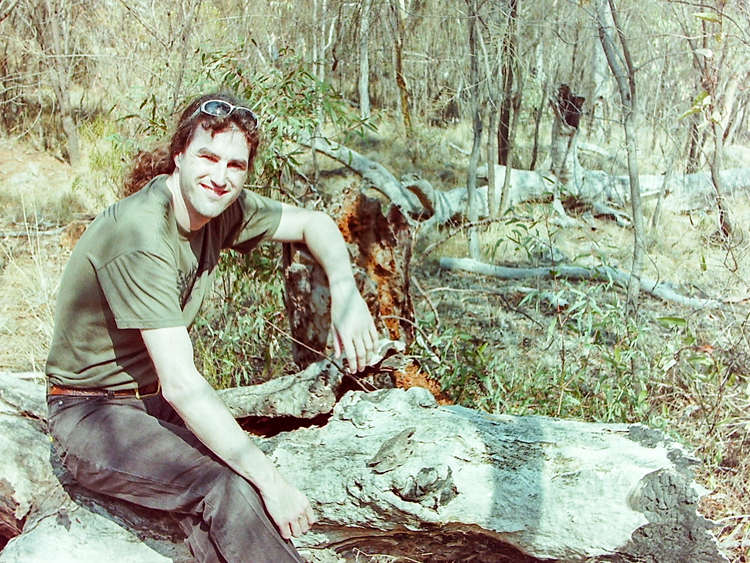
In the bush, sitting on a log that probably comprises 80% by weight venomous and deadly animals
Arrival in Canberra
Many moons ago, the Australians decided that their newly formed Federation of States needed a proper capital. The individual state capitals – Brisbane, Melbourne, Sydney, Adelaide, Perth, Hobart – fought long and hard for the privilege, until everybody got fed up with the bickering and decided to put the capital somewhere else.
A few sites were considered, but in the end the Australians took a patch of unremarkable sheep-farming land spanning the borders of New South Wales and Victoria, and made a new state, Australian Capital Territory, in which to build their new city. After some more in-fighting, during which committee-generated names such as SydMelAdPerBrisHo were suggested, the city was named Canberra.
The architect, something of a visionary called Burley-Griffin (or possibly his wife, but that’s another story), knew from the start that this city was going to be different. Rather than clear-fell and sterilise the area before putting up the buildings, he decided to insert the city into the bush itself. A lake was required as a focal point in this waterless wilderness, so he created not one but two by the judicious use of dams. Seven separate centres were built scattered about the new lakes, each with their own shopping malls, business zones and housing. Building plots were sold with the understanding that, once you’d built your property, the government would stock the garden with mature local trees and shrubs, and much of the land between the centres was designated as national parkland, forming huge stretches of green-belt wilderness criss-crossed only by cycle paths.
On our arrival some fifty years later, it was clear that the vision was still working. One of the first things any visitor should do is drive to the top of nearby Mount Ainslie, and look down over central Canberra. In front of you, you see the lake, the two parliament buildings – the old and the new – with the famous flagpole standing above them, and off to one side, a small cluster of office buildings that constitutes the centre of Civic. Everything else is bush and trees. But wait, just stand and concentrate… amongst the trees you see a house. And then another one. And another. Until you realise that what at first glance seems to be forest horizon to horizon, is actually all the living, breathing city of Canberra.

The centre of the capital of Australia, parliament in the middle.
We arrived by train from Sydney, on the basis that after twenty two hours (with only a one-hour break in Kuala Lumpur) on a plane from Holland, we couldn’t face even the local internal hop or another moment in an airport. It turned out to be an excellent decision, as well as an introduction to Australia in microcosm. Sitting in our air-conditioned first class seats, sipping local Chardonnay and dining on roast chicken, we soon found ourselves involved in numerous of conversations with passers by, interested to know who we were and what we were doing; imagine this happening on an intercity train in any European country.
Half way to Canberra, the train stopped unexpectedly. After about five minutes, the attendant (who up until now had mainly been saying things like “Next station is Wogga, population 12, the platform is very small and we are only stopping for two minutes, so please do not go wandering”) came on the tannoy to announce “We apologise for the fact that the train has stopped. The driver is now trying to restart the engine. When he succeeds we will be on our way…”
In the distance we could faintly hear the grind of an enormous diesel turning over; we could almost picture the driver standing on the track, winding a huge starting handle. Meanwhile, nobody so much as glanced at their watch or frowned. Conversations continued without interruption, and when the engine eventually shuddered into life and the train restarted its journey, nobody thought it worthy of comment.
Our arrival in the capital city was surreal. It was built to house a million souls, and so far only about 350,000 have moved in, so there is practically no traffic on the huge 3-lane highways, no public transport to speak of, and only one taxi company. Canberra International Airport is an airstrip borrowed from the air force, and when we arrived at the train station, it was like something out of a Western; a simple platform, baking heat, and nothing at all moving. All it needed was eerie harmonica music and a bouncing tumbleweed.
What traffic there is in Canberra, is mainly utes, what other cultures would call a flatbed or a pick-up. However, no bashed about working vehicles these. It is the dream of every young lad to own a ute, with darkened windows, pearlescent paint job, wide alloy wheels and a thundering exhaust. In fact, Ford and Holden (the local name for Vauxhall/Opel/GM) make hot utes just for this market, great for cruising in the evenings but not enormously useful for actually carrying stuff to market. For a moment I toyed with the idea of owning one myself, cruising across the red desert with arm on window ledge, stereo blaring… but then I realised that the other main vehicle here is the four wheel drive, somewhat more practical for the intense touring that we intend to do, and so off we went looking for a twin-cab Toyota Land Cruiser.
However, in a dusty corner of the Toyota dealership they had a part-exchanged Nissan Pathfinder, with electric everything, CD player, aircon, and for two thirds the price… after a test drive, I fell in love with it.
After the bush fires
Once you’ve got yourself a set of wheels, it is only an hour or so from Canberra up into the Snowy Mountains, which (like much of the ACT) is mainly national parkland. Much of it is natural bush, but great swathes of it were until recently experimental plantations of imported pine. These famously exploded into a firestorm shortly before our arrival, wiping out around four hundred houses in one of the outlying suburbs, and forests as far as the eye can see.
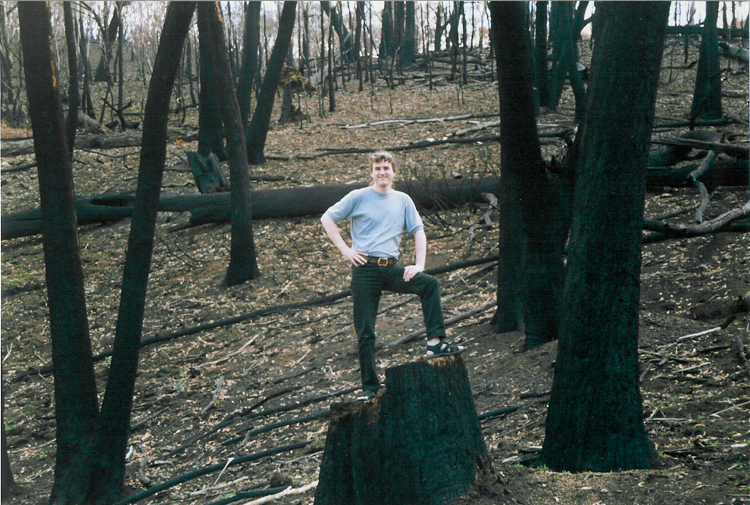
Burnt trees near Kosciusko
The pine plantations are all dead, mile upon mile of burnt sticks projecting from crumbly scorched earth, eerily silent apart from the buzz of flies around the occasional charcoaled animal corpse.
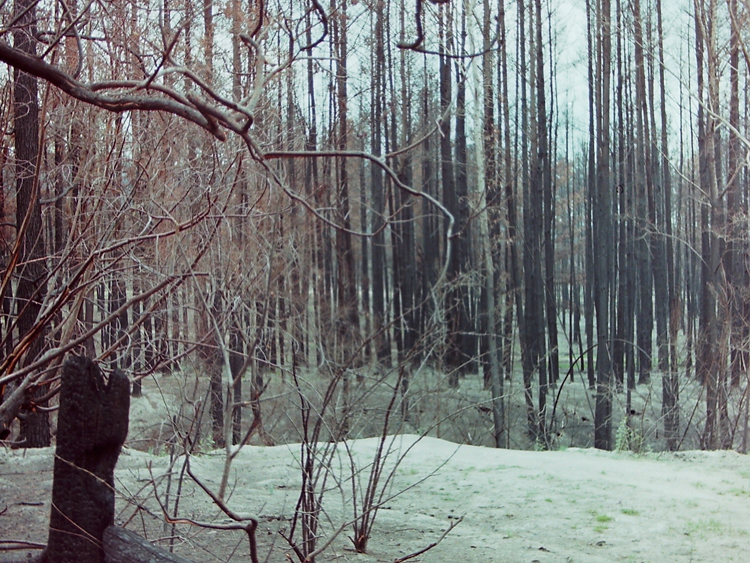
When the pine burns, that’s the end of it: Pine plantation near Stromlo
The local flora, on the other hand, is well adjusted to regular burning. Without an oily carpet of pine needles to keep the heat in, the earth below the native forest is unscarred, still healthy and brown, and heat-triggered seeds, dormant for years, spring into life to take advantage of the cleared growing conditions.
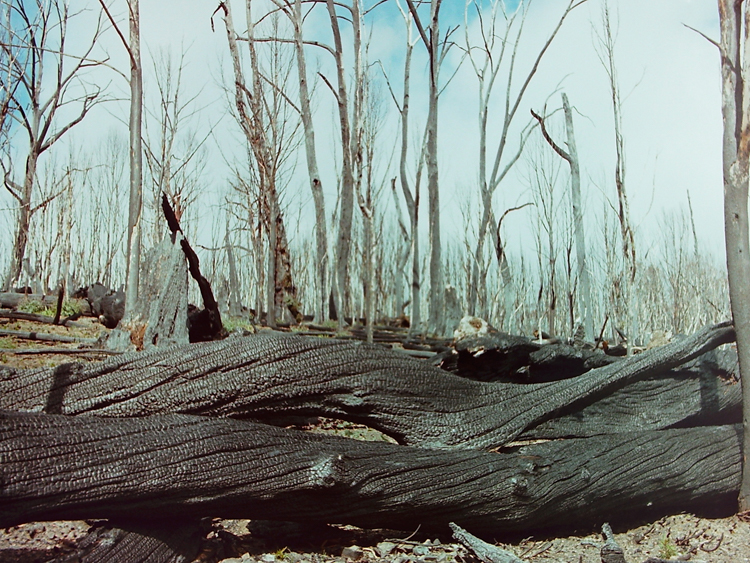
Burnt gums near Tidbinbilla
Native grasses burn back to a central nub, but soon sprout a short green felting of fresh tips. Up in the highlands, a ranger shows us a banksia, which has stubbornly refused to flower for the last fifteen years, covered in new buds triggered by the heat of the fire that has turned the surrounding limestone ash-white.
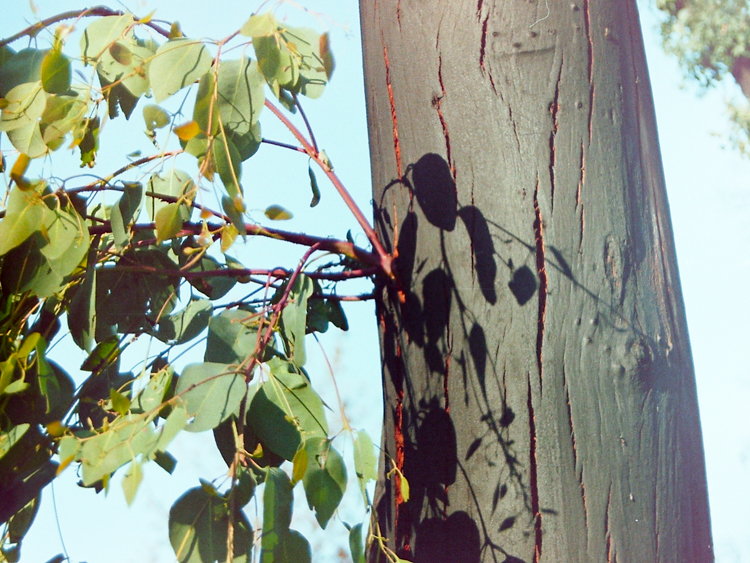
It doesn’t take long for a burned gum to re-sprout
The ubiquitous eucalypt’s flaky bark burns but then peels off, revealing fresh wood beneath, and hidden buds push their way through the charcoal, sprouting fresh and green against the black, all silhouetted against the stunning blue of the sky. So striking is this landscape – the 2003 firestorm notwithstanding, bush fires are a fact of life here – that I reckon that the Australian national colours should be black, green and blue.
Pine burns and is forever charcoal. In contrast, local plants such as this eucalypt pause for a week or so and then burst forth with new life.
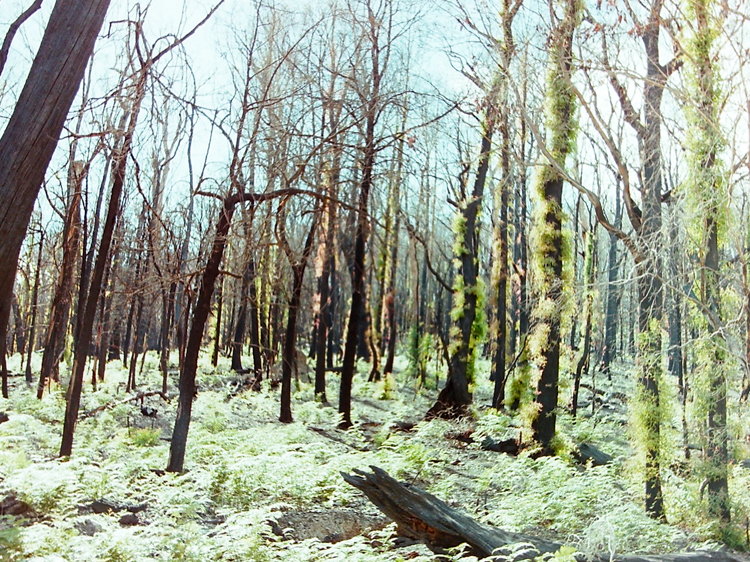
The bush eagerly regenerates
Somewhere to live
After a few weeks in a hotel, we managed to find a house. The rental industry here is certainly interesting; each property is made available for viewing for a single hour. In that time, as many hopeful renters pack in as possible; afterward, you all fill in your application forms. These forms are then shortlisted according to how much the agent liked you (chatting them up works wonders here), and then – get this – the short list is sent to the actual owners, who get the last word. If they don’t like foreigners, or people with odd names, or whatever, then out you go. Whether you’re the best tenant in terms of past history or income level is at this point completely irrelevant. Very strange.
After going through the mill a couple of times, we rented privately, which made a lot more sense, and we ended up with this vast (by European standards) 4-bedroom house practically on the shores of Lake Gininderra, and a short cycle ride to work.
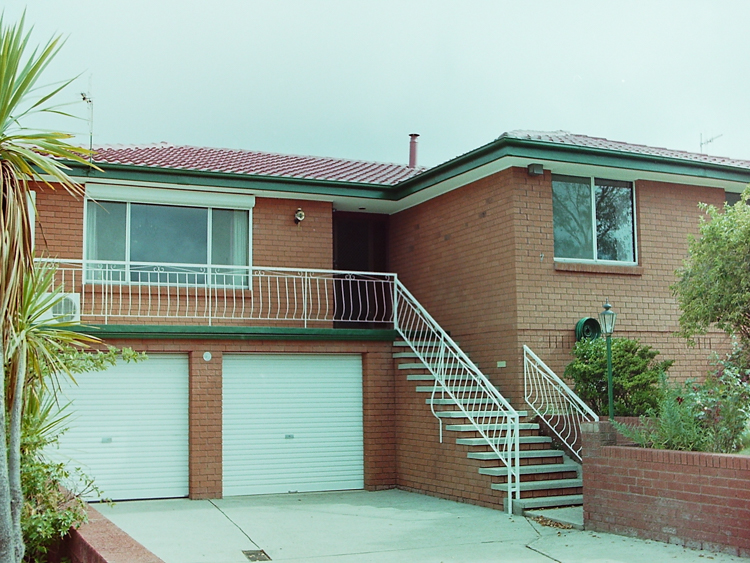
Bijou Pad
And what a cycle ride! To commute to my office, I cycle down a mud track to the lake, and then pedal around the shore, past the pelicans and cormorants, with parrots and cockatoos flying overhead, swerving to avoid bright blue swamp-hens, until I arrive at the office. How cool is that?
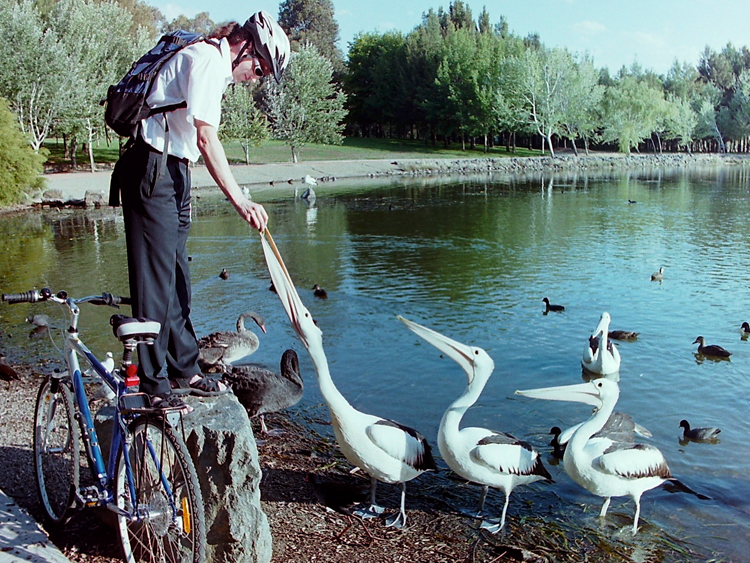
Feeding the pelicans
On the way home from work, I often meet Lyn by the lake-shore and we feed the pelicans, swans and ducks. You get a few scratches – they’re big creatures, and wild and excitable – but smart, the way most Australian bird life seems to be smart, and easily taught which bits are food and which bits need gentler treatment.
Back at the house, I built a bird feeding station, in an attempt to attract some wildlife, with extraordinary results; we regularly see twenty parrots, a dozen cockatoos, as many bronze-wings (sort of pigeon-like with dinosaur crests), magpies (big smart piebald birds), sundry smaller critters, and even a goshawk that catches prey and then nonchalantly plucks it on our lawn.
Australians often tell you that Canberra is boring. They are wrong.
No worries. No worries at all.